Memories of Yesteryear
Part 3
1914-1918: The Great War in the saddle
It was during the First World War that the military motorcycle made its debut, although it had also appeared with the forces of Pancho Villa in the earlier Mexican Revolution. Pancho Villa discovered that the big Indian motorcycles were ideal for his raiding parties, realising that motorcycles offered the speed and agility ideal for hit and run raids.
The Great War set the tone for the mechanisation of war and the motorcycle proved to be a very viable replacement for the horse, with the military making extensive use of this new method of transport and communication.
Technological breakthroughs are often driven by necessity during war and the Great War was no exception. The increased need for motorised transport unsurprisingly directly influenced motorbike production, greatly accelerating their evolution. These were bikes built out of, and during a crisis - bikes designed for rugged applications.
It's no coincidence that many early motorcycle manufacturers were also manufacturers of guns and armaments.
Detailed below is a photographic record of some of those military machines of yesteryear.
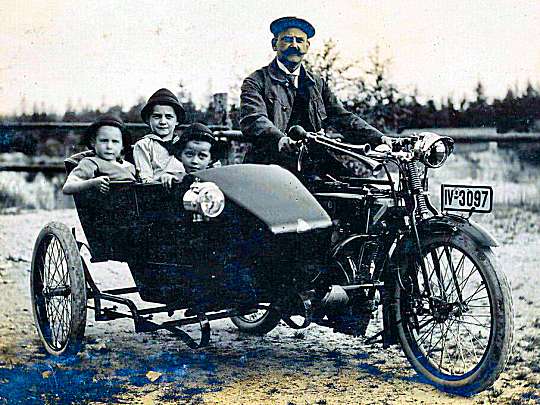
A civilian and his children prior to Germany declaring war on the Russian Empire: (1 August 1914). Two days later, Germany declared war on France and invaded Belgium. On 4 August 1914, the UK engages its colonial empire in the conflict.
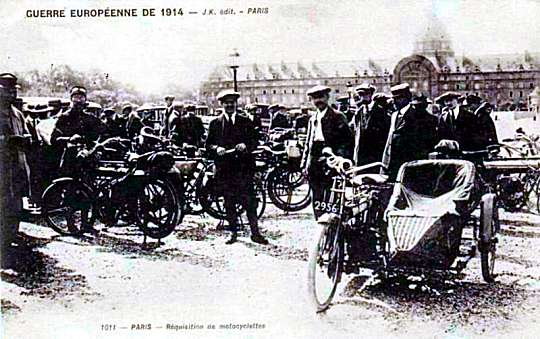
The requisition of motorcycles in Paris.
In France, general mobilisation ensured the immediate right of requisition on people and goods. All motorcycle owners, (the ideal liaison vehicles), were required by law to present their machines to the authorities and motorcycles were systematically requisitioned.
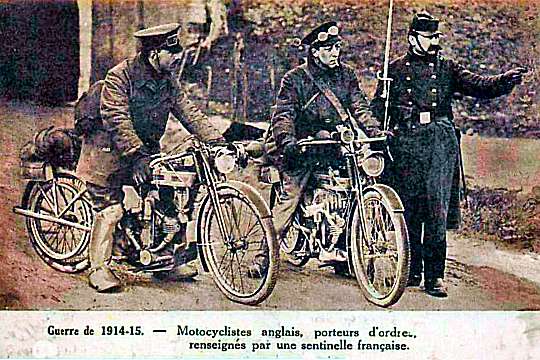
Two British dispatch riders receiving information from a French sentry.
Dispatch riders had the dangerous and demanding job of delivering messages to the front lines and carrying out reconnaissance work. Motorcycles were of course very manoeuvrable and able to get in and out of tight locations impassable to other vehicles.
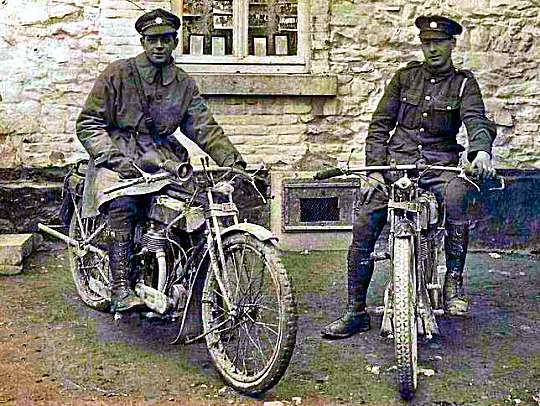
Two Royal Engineers dispatch riders on their Triumphs.
Triumph motorcycles were started in Britain by a German immigrant from Nuremberg called Siegfried Bettmann who set up his business in Coventry and also later a German branch in Nuremberg. Before the outbreak of war, the two companies were set up to operate under different names. In Britain they were called Triumph whilst in Nuremberg the brand was TWN, (Triumph Werke Nurnberg)

A belt-driven Douglas. Manufacturers Douglas, Triumph, Royal Enfield, Norton, BSA, Matchless, Sunbeam, Scott, Clyno, Blackburne, Rover, New Hudson, Hazlewood, Phelan & Moore, Zenith, Lewis, Kynoch and Torpedo. All contributed bikes to the British war effort, with many were given lucrative military contracts.
It's estimated that Douglas alone produced 70,000 bikes for the allied forces. Of these, 25,000 were 348cc twin-cylinder machines, specially made for the army's newly mobile dispatch riders. Triumph, meanwhile, boasted a British order for 30,000, though it also supplied Greek dispatch riders with 550cc single-engine bikes. Royal Enfield also manufactured for the UK war department; notably winning a contract to supply the Russians too.
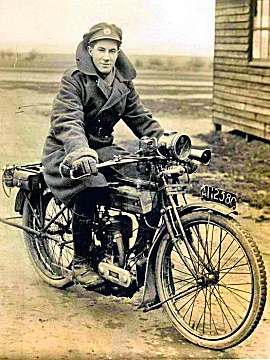
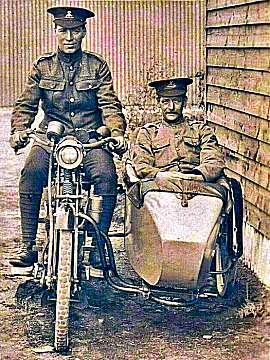
British soldiers and their machines. Carburettors were obviously very crude, and more often than not there would be problems with carburation and ignition systems, especially in arduous or damp conditions. Usually in the sidecars there would be petrol, oil and carbide for the lamps.
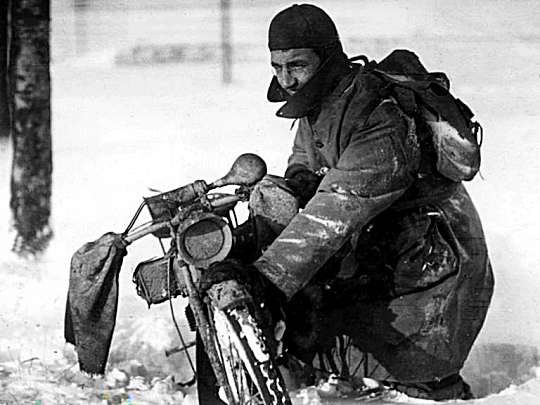
A soldier of the Signal Corps and his Douglas in the snow on the road to St Pol sur Ternoise, Northern France.
The belt drive transmission was quite smooth as there was no chain to jerk about. But if it rained hard or if you were trying to ride in the snow, the belt would probably slip, sliding around on the pulleys. Riders used to have a ready supply of sand which they would simply sprinkle over the belt and pulleys to regain grip. If they found themselves in the countryside, then they'd sprinkle some earth over the belt.
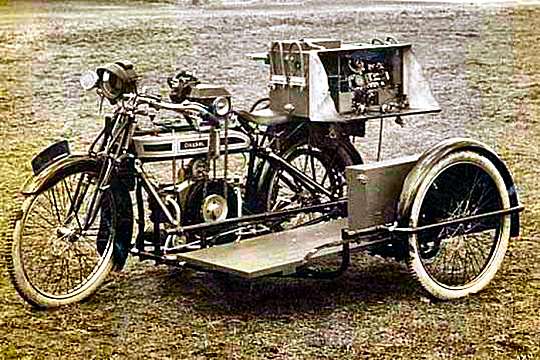
A version of the Douglas as a radiophonic liaison station
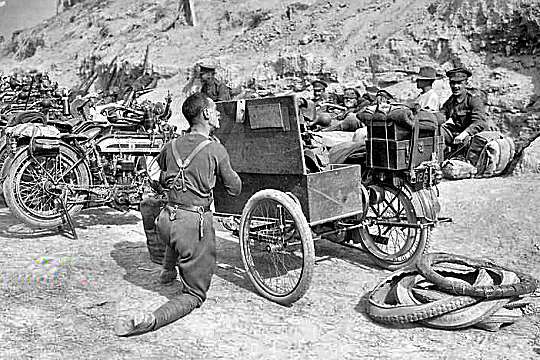
A workshop sidecar, also practical as the mechanic's bathroom
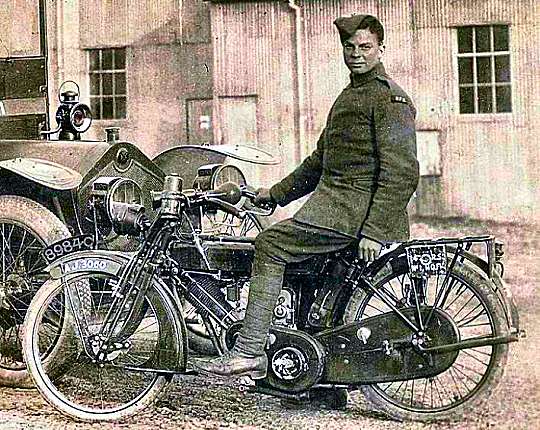
The Phelon & Moore brand was the official brand of the Royal Flying Corps and then of the Royal Air Force.
Three Phelon & Moore models were in service: the rarest being the 770 cc V-twin; the most famous was the 500cc with its sloper engine (here in the photo); and the third version coming with a sidecar. In 1921 the brand adopted the name Panther
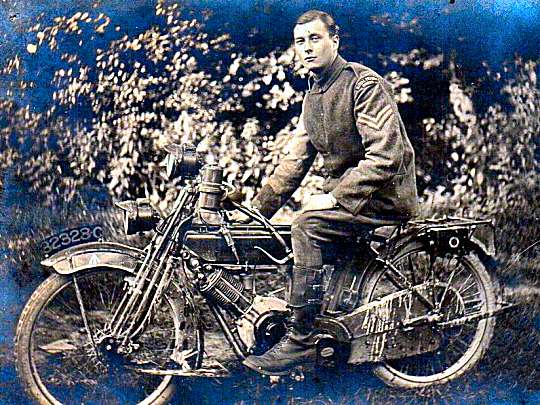
1916 - A Royal Flying Corps officer with a customised Phelon & Moore machine equipped with two carbide headlights and racing style handlebars.
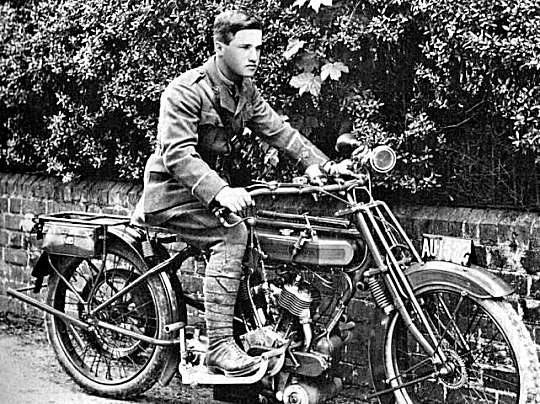
1915 - The Royal Flying Corps ace pilot Albert Hall (44 Air Battle victories) on a Hazlewood (JAP V-twin engine).
During the 1914-1918 war Hazlewoods had to suspend motorcycle production in favour of the production of armaments.
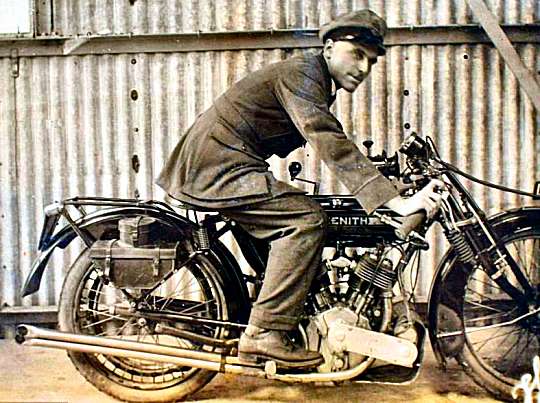
A Zenith 'Gradua' type, (under Norton control from 1914 to 1918), with variable pulley, JAP 650 cc 2 cylinder 4-stroke engine.
On the bike Captain Denis Carey of the Royal Naval Air Service, Irish hammer-throwing athlete, victorious at the 1912 Olympic Games.
The "Gradua" variable-ratio belt drive transmission simultaneously changed the diameter of the crankshaft belt-drive pulley to alter the drive ratio, while moving the rear wheel forward or back to maintain belt tension. The Gradua's action was controlled by a rotating lever atop the fuel tank, and was among the first attempts to provide multiple drive ratios for a motorcycle, at a time when very simple, direct belt-drive transmission was the industry norm. Variable drive ratios proved a significant advantage in competition, leading riders of other brands to complain the Gradua gave an unfair advantage. Eventually Zeniths with Gradua gears were banned from many competitions. Zenith capitalised on this ban, adding the word "Barred" to their advertising and logo.
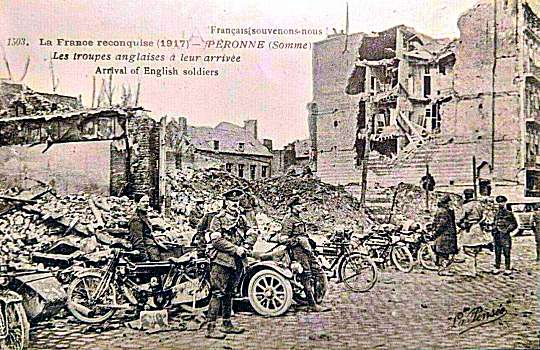
A French postcard with the title "French remember!" Showing the arrival of English soldiers and their motorcycles in Peronne, in the Somme, during the reconquest of France in 1917
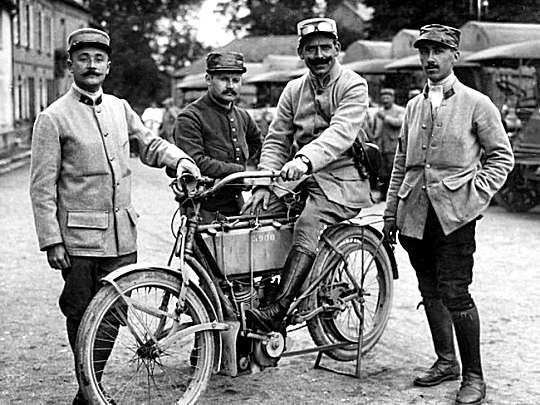
Repainted and without any other modification than a registration number on the tank, the requisitioned two-cylinder Peugeots were the French motorcycles most often found in the hands of French soldiers.
First installed in Vincennes, the motorised military park was then transferred to the Montlucon artillery park. This is where, among other things, the first motorcycle sections were formed, equipped with new machines from Clement-Gladiator, (two or three dozen), and Triumph (one hundred); the only two brands selected by the park manager.
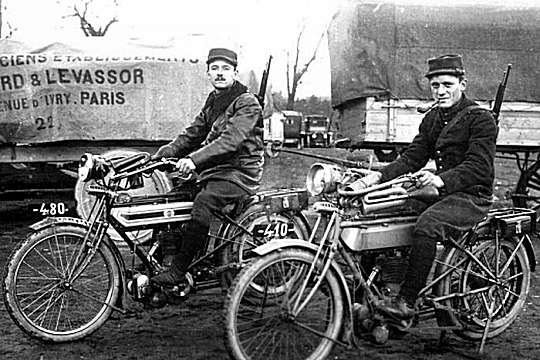
December 1914 - French soldiers on Triumphs.
The machines are identical but the 480 was obviously requisitioned because we can just about see the remains of a civilian registration on the front mudguard.
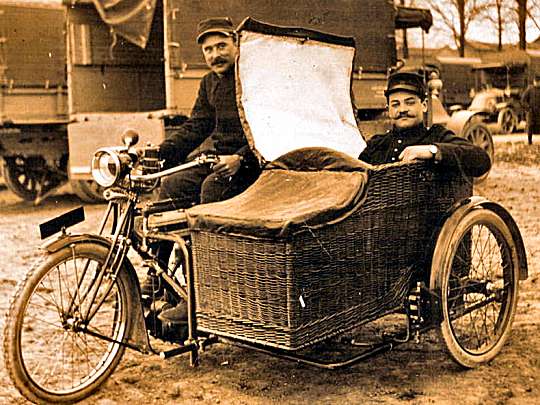
The French motorcycle soldier of the Great War had a soft spot for British motorcycles because the French requisition motorcycles, already few in number, quickly reached their limits in terms of performance and reliability
Vintage drawings showing French dispatch riders in action during the Great War
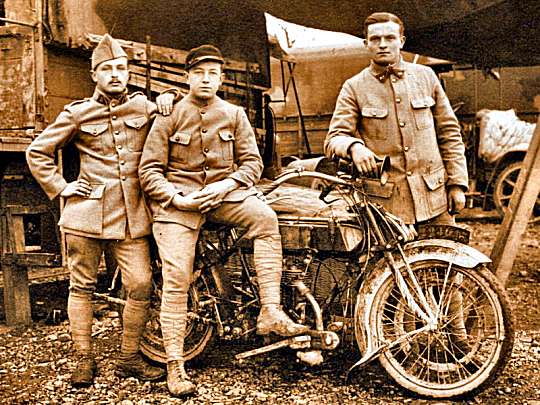
French soldiers at the front, (seen here with a BSA outfit), all wore the 'kepi' when on duty; the 'calot' (field service) is worn at rest.
The metal helmet did not appear until 1915, when trench warfare began, which was responsible for many fatal head injuries.
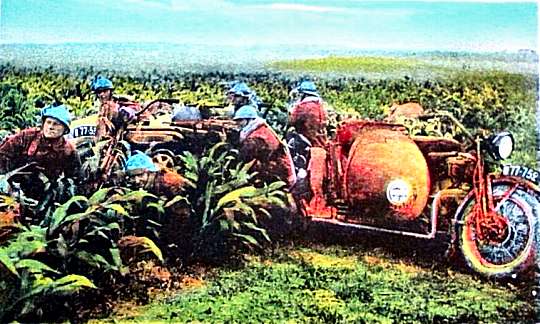
Circa 1915 - French soldiers and their machines in ambush.
The gaudy colour of their uniforms, their helmets, and their machines at the time didn't help with camouflage ...
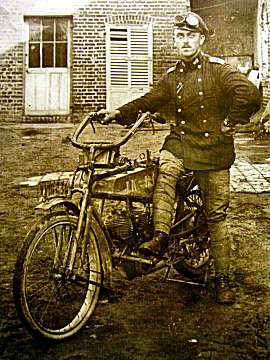
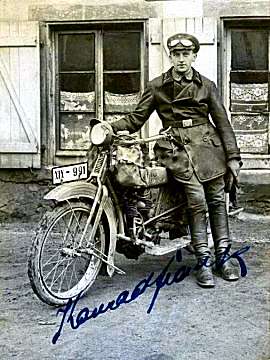
The first German motorcycles to make their way to the front lines were the Wanderer (left), the NSU (right) and the TWN (Triumph Werke Nurnberg)
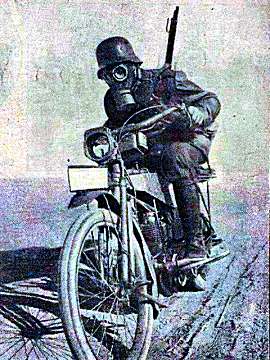
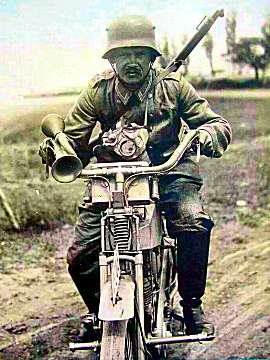
German Wanderer machines were of advanced design boasting unit construction engines and front and rear suspension as early as 1915, at which time they were supplied to the German army.
Wanderer supplied almost half of all machines used by the German forces during the Great War, and by 1918 had built over 10,000 motorcycles. Baron Klaus-Detlof von Oertzen arranged the sale of the motorcycle business to NSU in 1929. The Wanderer design was licensed to a Czech manufacturer, resulting in the Jawa brand.
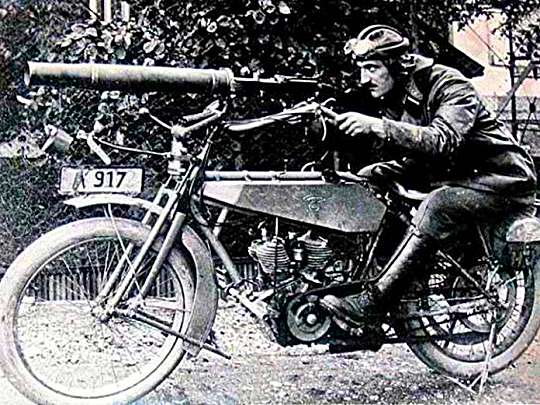
A German Wanderer equipped with a machine gun. In the summer of 1914, both sides deployed 2,000 machine guns to the front.
Although the Netherlands remained neutral during World War I, the Dutch military motorcycle squad of the Royal Netherlands Army was mobilised throughout the conflict, as belligerents regularly attempted to intimidate the Netherlands and place demands on it

The Russians were not left out with outfits also equipped with machine guns. Here are soldiers from the 39th Infantry Regiment of Tomsk.
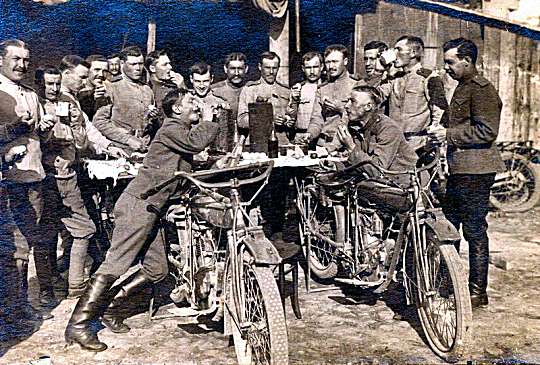
Being at war does not prevent Easter from being celebrated with a good improvised Russian lunch and washed down with a lot of vodka ...
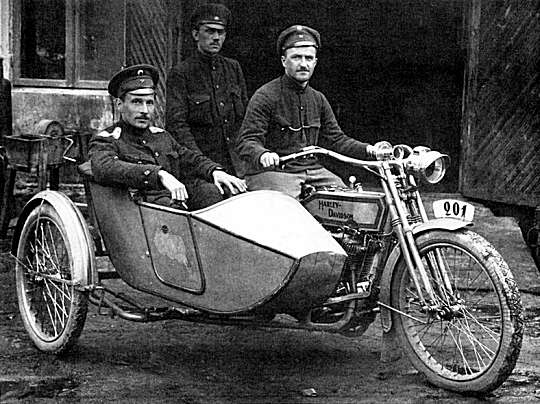
Although Russians didn't have any motorcycle manufacturer a century ago, they were riding American motorcycles (Indian and Harley-Davidson) during the Great War
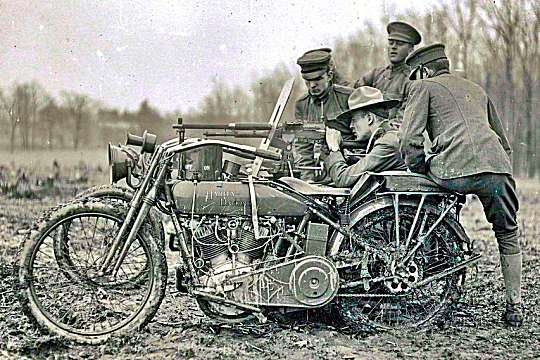
On 6 April 1917, the United States declared war against Germany. World War I was the first time in American history that the United States sent soldiers abroad to defend foreign soil.
The first American troops arrived in Europe in June 1917.
The American Expeditionary Forces (AEF) did not fully participate at the front until October, when the First Division entered the trenches at Nancy, France.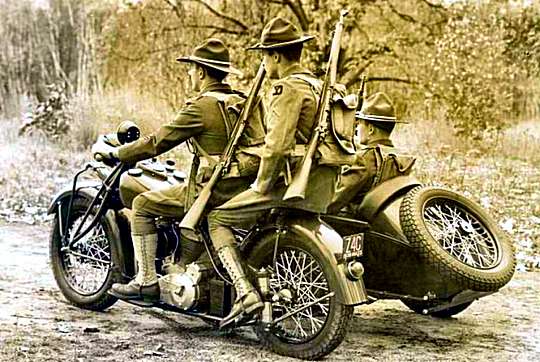
It has been estimated that the US ordered over 80,000 bikes for military use during WWI - clearly the motorbike held an important place among the troops.
By the end of 1917, Harley-Davidson had provided around 15,000 bikes for the war effort. Approximately one third of all Harleys made in 1917 and 1918 were bought for war use.
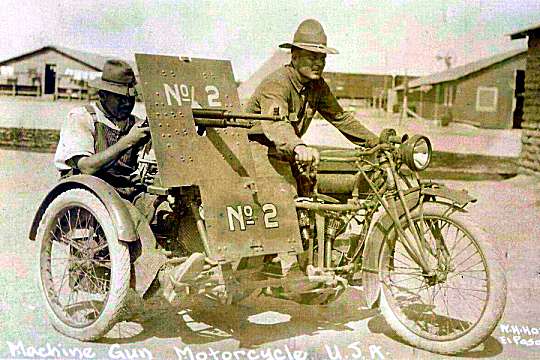
At the outset of World War I, Indian was at the forefront of the motorcycle world. When the U.S. announced its entrance into the conflict, the manufacturer dedicated nearly all of its production resources to the war effort.
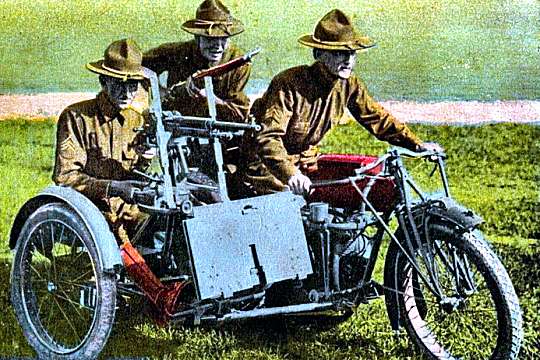
The result was 50,000 Indian PowerPlus Big Twins, which were both faster and, thanks to a swanky rear suspension, more manoeuvrable than their Harley counterparts
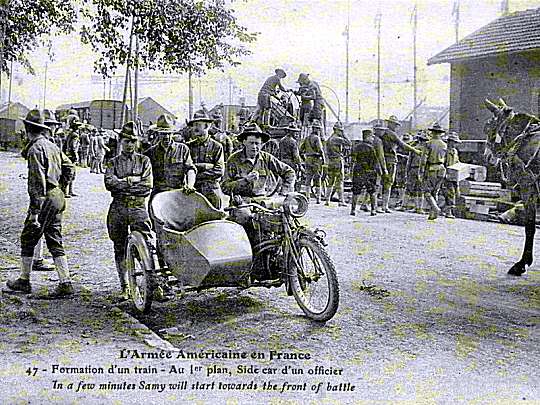
The American army in France, in Saint-Nazaire. The first 14,000 U.S. infantry troops landed in France at the port of Saint-Nazaire, Brittany. The landing site had been kept secret because of the menace of German submarines.
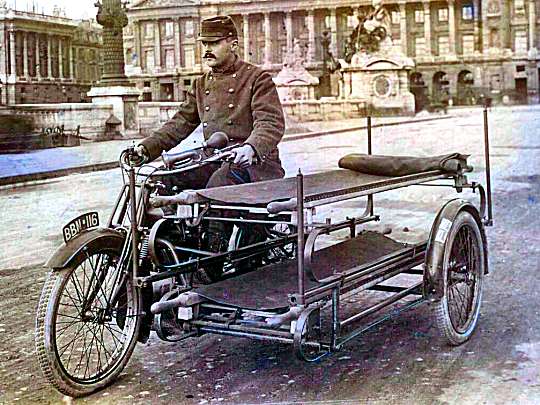
Motorcycle ambulances were an innovation in WW1, used by the British, French and American militaries, as well as non-governmental support groups like the Red Cross.
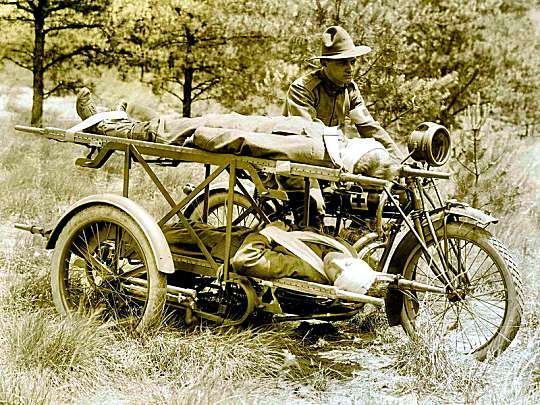
Four-wheeled ambulances were very heavy, underpowered, poorly suspended, and used solid tyres, making them slow, unwieldy, bumpy, and likely to get stuck in rough, muddy ground common near European battlefields. Smaller, lighter ambulances were required, and motorcycles with sidecars proved very useful near the front lines to move wounded soldiers away from the heat of battle
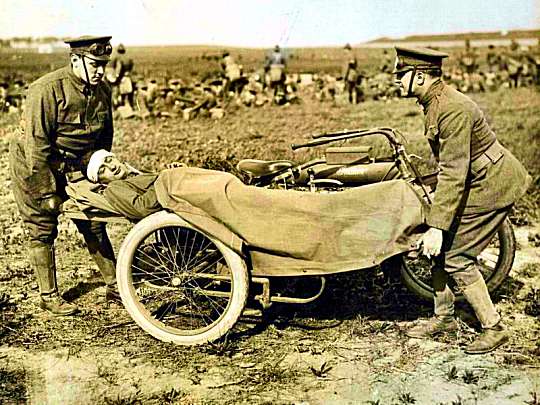
American forces and the Red Cross used Indian and Harley-Davidson motorcycles for ambulance and medical transport duties. Both makes had reliable motors and 3-speed gearboxes with robust clutches, and were very lightweight. The faster an injured soldier was treated, the more likely he was to survive, so getting them away from the front as quickly as possible was crucial.
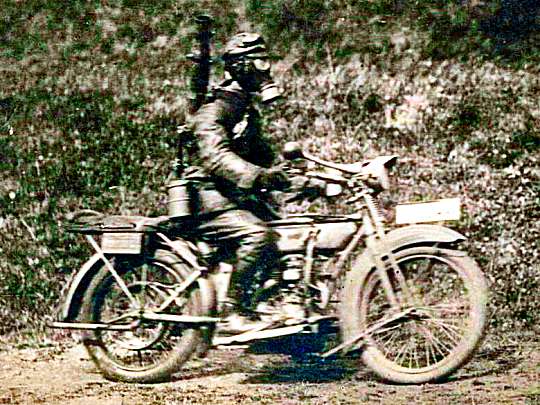
No, he's not a motorcyclist on his way to a rally, at the time of the COVID-19 pandemic! Armies quickly produced gas masks that gave protection as long as sufficient warning was given of a gas attack.
The total number of military and civilian casualties in World War I was around 40 million. Estimates range from around 15 to 22 million deaths and about 23 million wounded military personnel, ranking it among the deadliest conflicts in human history.
Disease, including the 1918 flu pandemic (and deaths while held as prisoners of war), accounted for about one third of total military deaths.
To put things in perspective, the confirmed global virus deaths due to the current coronavirus pandemic, on 19 July 2020, is nearly 603,000.
- Jean-Francois Helias